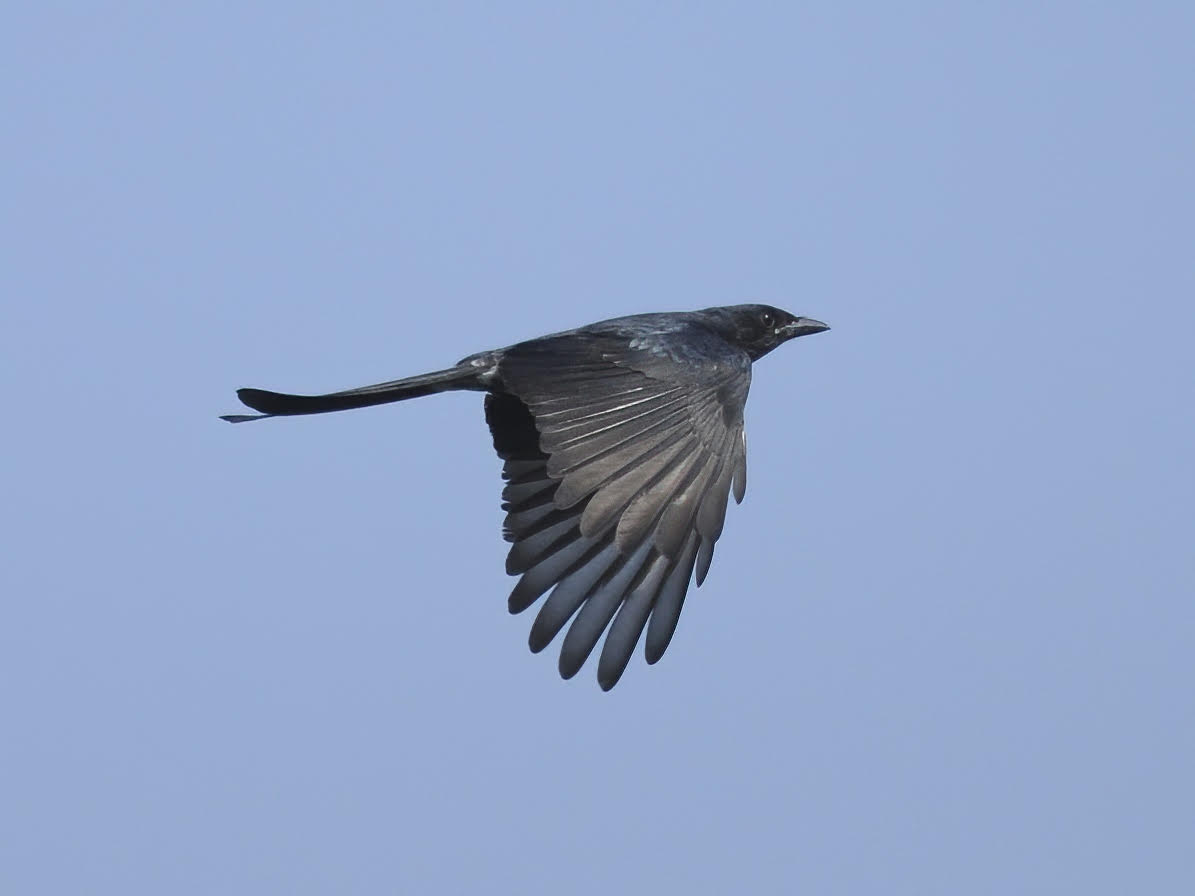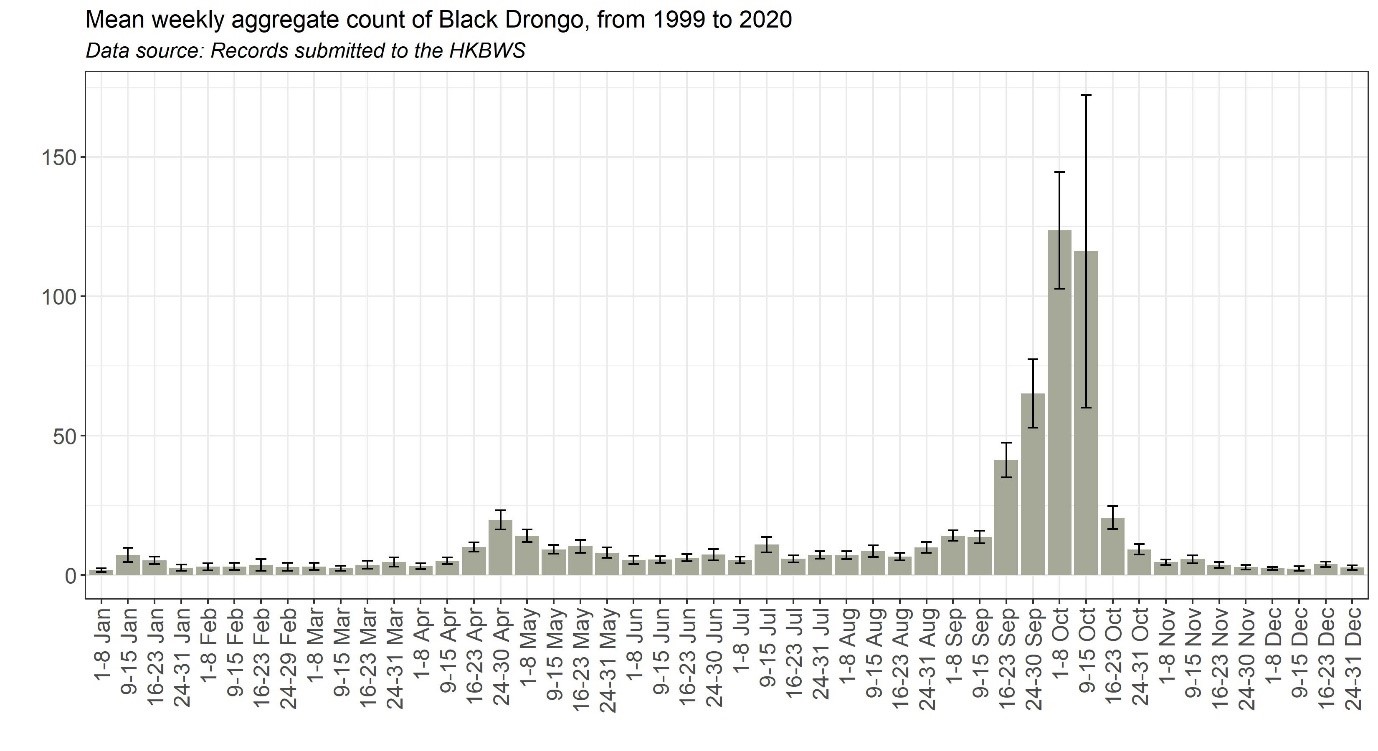Black Drongo Dicrurus macrocercus 黑卷尾
Category I. Common summer visitor, larger numbers on passage especially autumn, and regular in winter in low numbers. Occurs in open country areas with scattered trees or artificial perches.
IDENTIFICATION

Oct. 2013, Michelle and Peter Wong. Juvenile.
30-31 cm. Largely dark drongo with relatively large bill and deeply forked tail (outer feathers only slightly upturned). Sexes alike. Adult has uniform black plumage with indistinct bluish gloss on wings and tail. Eye dark brown.
Juvenile (illustrated) has browner body plumage browner and a metallic gloss confined to upperparts. Feathers of chest centre and belly, rump, underwing and undertail coverts edged with white.

Oct. 2013, CHUNG Yun Tak.
In flight wings broad and rounded, tail length approximately equal to body length. Tips of tail fork tilt upward slightly, but much less than Hair-crested Drongo.
VOCALISATIONS
Vocalisations are generally harsh and lacking in melody. The song is a variable mixture of harsh and shrill notes.
Calls include both single notes and a short series not dissimilar to the song.
DISTRIBUTION & HABITAT PREFERENCE
Favours lowland open country with scattered trees, but also found on offshore islands. In breeding season, as long as song posts, hunting perches and large trees for nest sites are available, it is commonly found around fish ponds, active and abandoned agricultural areas, edges of villages, open conifer woodland, open storage sites and grassland/shrubland.
A sharp decline in range was indicated by the breeding bird surveys of 1993-96 and 2016-19 from 32.3% to 10.1% of 1km squares. Previously widespread in lowland or coastal open habitats throughout HK, it is now largely absent from many parts of the New Territories, Lantau, HK Island and Lamma.
Its range in winter is much smaller than in the breeding season, covering 2.0% of the 1km squares in the winter atlas of 2001-05 and 1.8% in that of 2016-19. In winter it is most commonly found in the northwest New Territories but also other scattered sites.
Early HKBWS records show that it was common on HK Island during the 1960s, and until the late 1970s there were even occasional records from the heart of Central in both winter and summer. The distribution generally began to contract in the 1980s (e.g., Viney 1996), when urbanisation in the New Territories and the resultant disappearance of suitable habitats on the urban fringe intensified.
OCCURRENCE
Black Drongo is a diurnal passage migrant in both spring and autumn. Spring passage generally begins in mid-April and continues to mid-May (Figure 1). Typical spring passage counts consist of loose aggregations of ten to 20 birds, but large flocks are not noted. Most breeding sites are occupied by the end of May.
Autumn passage is much stronger than spring, peaking from mid-September to mid-October. At this time of year counts of up to 20 birds are typical but larger movements do occur. A minimum of 1,000 individuals was observed passing over Mai Po Nature Reserve on 12 October 2010, the highest count on record. Other high counts mostly occur in October, e.g., 271 on 12 October 2015 at Fan Lau and 160 on 2 October 2013 at Mai Po.
Winter records of Black Drongo are not unusual but typically consist of single birds seen at or near breeding areas. Occasionally larger groups occur but counts over ten are unusual; the highest are 44 on 17 February 2019, 31 on 9 January 2019, 18 on 20 January 2008, all at Mai Po.
Black Drongo was first observed in HK by Swinhoe (1861) who did not consider it common, though presumably he was referring only to HK Island.
BREEDING
Black Drongo is probably the principal host species for the Indian Cuckoo in HK. Cuckoo chicks, thought to be Indian Cuckoos, have been found in Black Drongo nests, and a fledged Indian Cuckoo chick has been seen being attended by adult Black Drongos.
Black Drongos begin to pair up late April and early May, while fledglings are observed from late June to mid-September. The density of the breeding population is variable. Most occupied 1km squares probably hold only a few breeding pairs but exceptionally in undisturbed suitable habitat densities can be high, e.g., up to 18 pairs on Stonecutters from 1959 to 1997. On other islands, there were at least six pairs on Po Toi from 2006 to 2008 and at least four pairs on Lamma in 2017.
BEHAVIOUR, FORAGING & DIET
Typically occurs singly or in small groups. Forms larger flocks during passage, especially in autumn. Little detail is available regarding its diet in HK but is known to prey on flying insects such as dragonflies. In addition, Young (1989) described a Black Drongo devouring a prinia.
RANGE & SYSTEMATICS
Present all year in the Indian subcontinent, Indochina and south China and summer visitor in much of central, east and northeast China. D. m. cathoecus, which occurs in HK, breeds in China east and south of Qinghai and Jilin, including Hainan, east and south Myanmar, north Thailand and north Indochina; it winters in southwest and south Myanmar, south Malay Peninsula and south Indochina (Rocamora & Yeatman-Berthelot 2020).
CONSERVATION STATUS
IUCN: Least Concern. Population trend unknown.
Figure 1.

Swinhoe, R. (1861). Notes on the ornithology of Hong Kong, Macao and Canton, made during the latter end of February, March, April, and the beginning of May 1860. Ibis 1861: 23-57.
Rocamora, G. and D. Yeatman-Berthelot (2020). Black Drongo (Dicrurus macrocercus), version 1.0. In Birds of the World (J. del Hoyo, A. Elliott, J. Sargatal, D. A. Christie, and E. de Juana, Editors). Cornell Lab of Ornithology, Ithaca, NY, USA. https://doi.org/10.2173/bow.bladro1.01
Viney, C. A. (1996). Mount Nicholson – Hong Kong – 1978-1995 – a natural history. Privately publd. by author, Hong Kong.
Young, L. (1989). Black Drongo taking wren-warbler sp. at Mai Po. Hong Kong Bird Report 1988: 118-119.

